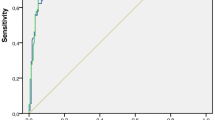Abstract
In this study, we aim to determine the diagnostic performance of nonattenuation-corrected (NAC) and attenuation-corrected (AC) FDG-PET/CT images in the assessment of solitary pulmonary nodule (SPN). We reviewed the images of 41 patients who underwent FDG-PET/CT to diagnose SPNs. The visual analysis of FDG uptake intensity in SPN on AC and NAC PET images was made using a four-point score from 1 to 4 on both AC and NAC PET images. The cutoff value of SUVmax and visual uptake scores for malignancy were defined as ≥2.5 and ≥3, respectively. The significant visual uptake (≥2 visual point score) on AC and NAC PET images was considered to be positive 18F-FDG PET findings for lesion detectability. The sensitivity, specificity and diagnostic accuracy were calculated for AC and NAC PET images. Based on the histopathology and imaging data, 22 of the SPNs (54 %) were malignant and 19 of them (46 %) were benign. The sensitivity and NPV were found to be 100 % in the detection of SPNs for AC and NAC PET images. For all SPNs and SPNs ≤2 cm, NAC PET image had a higher diagnostic performance for the SPN characterization as malignant or benign, when compared with AC PET image. The success rates of AC and NAC PET images were found to be similar for the detection of SPNs. NAC PET image had a higher diagnostic performance for the SPN characterization. It is thought that NAC PET image may provide additional contributions for characterization of SPNs.


Similar content being viewed by others
References
Sim YT, Poon FW (2013) Imaging of solitary pulmonary nodule: a clinical review. Quant Imaging Med Surg 3:316–326
Ost D, Fein AM, Feinsilver SH (2003) The solitary pulmonary nodule. N Engl J Med 348:2535–2542
Hansell DM, Bankier AA, MacMahon H, McLoud TC, Müller NL, Remy J (2008) Fleischner society: glossary of terms for thoracic imaging. Radiology 246:697–722
Wahidi MM, Govert JA, Goudar RK, Gould MK, McCrory DC, American College of Chest Physicians (2007) Evidence for the treatment of patients with pulmonary nodules: when is it lung cancer?: ACCP evidence-based clinical practice guidelines (2nd edition). Chest 132:94–107
Midthun DE (2013) Early diagnosis of lung cancer. F1000 Prime Rep 5:12
Henschke CI, Yankelevitz DF, Naidich DP, McCauley DI, McGuinness G, Libby DM et al (2004) CT screening for lung cancer: suspiciousness of nodules according to size on baseline scans. Radiology 231:164–168
Bar-Shalom R, Valdivia AY, Blaufox D (2000) PET imaging in oncology. Semin Nucl Med 30:150–185
Blokland JA, Trindev P, Stokkel MP, Pauwels EK (2002) Positron emission tomography: a technical introduction for clinicians. Eur J Radiol 44:70–75
Turkington TG (2001) Introduction to PET instrumentation. J Nucl Med Technol 29:4–11
Kapoor V, McCook BM, Torok FS (2004) An introduction to PET-CT imaging. Radiographics 24:523–543
Huang YE, Pu YL, Huang YJ, Chen CF, Pu QH, Konda SD et al (2010) The utility of the nonattenuation corrected 18F-FDG PET images in the characterization of solitary pulmonarylesions. Nucl Med Commun 31:945–951
Reinhardt MJ, Wiethoelter N, Matthies A, Joe AY, Strunk H, Jaeger U et al (2006) PET recognition of pulmonary metastases on PET/CT imaging: impact of attenuation-corrected and non-attenuation-corrected PET images. Eur J Nucl Med Mol Imaging 33:134–139
Degirmenci B, Wilson D, Laymon CM, Becker C, Mason NS, Bencherif B et al (2008) Standardized uptake value-based evaluations of solitary pulmonary nodules using F-18 fluorodeoxyglucose-PET/computed tomography. Nucl Med Commun 29:614–622
Dalli A, Selimoglu Sen H, Coskunsel M, Komek H, Abakay O, Sergi C et al (2003) Diagnostic value of PET/CT in differentiating benign from malignant solitary pulmonary nodules. J BUON 18:935–941
van Gómez López O, García Vicente AM, Honguero Martínez AF, Jiménez Londoño GA, Vega Caicedo CH, León Atance P et al (2015) (18)F-FDG-PET/CT in the assessment of pulmonary solitary nodules: comparison of different analysis methods and risk variables in the prediction of malignancy. Transl Lung Cancer Res 4:228–235
Bengel FM, Ziegler SI, Avril N, Weber W, Laubenbacher C, Schwaiger M (1997) Whole-body positron emission tomography in clinical oncology: comparison between attenuation-corrected and uncorrected images. Eur J Nucl Med 24:1091–1098
Kotzerke J, Guhlmann A, Moog F, Frickhofen N, Reske SN (1999) Role of attenuation correction for fluorine-18 fluorodeoxyglucose positron emission tomography in the primary staging of malignant lymphoma. Eur J Nucl Med 26:31–38
Lonneux M, Borbath I, Bol A, Coppens A, Sibomana M, Bausart R et al (1999) Attenuation correction in whole-body FDG oncological studies: the role of statistical reconstruction. Eur J Nucl Med 26:591–598
Joshi U, Raijmakers PG, Riphagen II, Teule GJ, van Lingen A, Hoekstra OS (2007) Attenuation-corrected vs. nonattenuation-corrected 2-deoxy-2-[F-18]fluoro-d-glucose-positron emission tomography in oncology: a systematic review. Mol Imaging Biol 9:99–105
Kim SK, Allen-Auerbach M, Goldin J, Fueger BJ, Dahlbom M, Brown M et al (2007) Accuracy of PET/CT in characterization of solitary pulmonary lesions. J Nucl Med 48:214–220
Raylman RR, Kison PV, Wahl RL (1999) Capabilities of two- and three-dimensional FDG-PET for detecting small lesions and lymph nodes in the upper torso: a dynamic phantom study. Eur J Nucl Med 26:39–45
Miller TR, Wallis JW, Grothe RA Jr (1990) Design and use of PET tomographs: the effect of slice spacing. J Nucl Med 31:1732–1739
Houseni M, Chamroonrat W, Basu S, Bural G, Mavi A, Kumar R et al (2009) Usefulness of non attenuation corrected 18F-FDG-PET images for optimal assessment of disease activity in patients with lymphoma. Hell J Nucl Med 12:5–9
Yilmaz F, Tastekin G (2015) Sensitivity of (18)F-FDG PET in evaluation of solitary pulmonary nodules. Int J Clin Exp Med 8:45–51
Author information
Authors and Affiliations
Corresponding author
Ethics declarations
Conflict of interest
All authors declare that they have no conflict of interest.
Ethical approval
For this type of study formal consent is not required.
Funding
There is no funding.
Rights and permissions
About this article
Cite this article
Şahin, E., Kara, A. & Elboğa, U. Contribution of nonattenuation-corrected images on FDG-PET/CT in the assessment of solitary pulmonary nodules. Radiol med 121, 944–949 (2016). https://doi.org/10.1007/s11547-016-0681-y
Received:
Accepted:
Published:
Issue Date:
DOI: https://doi.org/10.1007/s11547-016-0681-y




